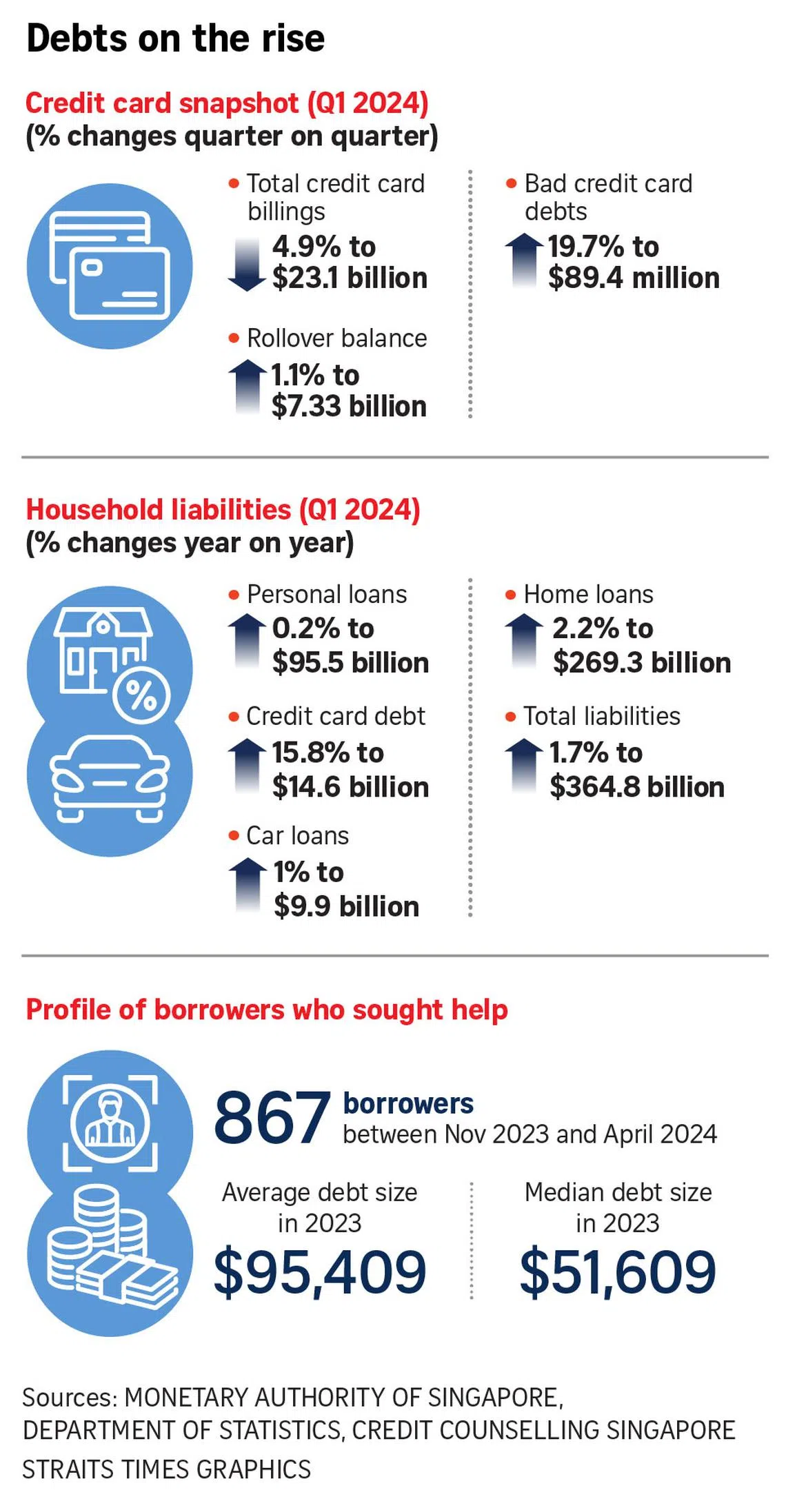Rise in credit card and other unsecured debt in S’pore even as card billings fall
Sign up now: Get ST's newsletters delivered to your inbox

The credit card rollover balance crossed the $7 billion mark, rising to $7.25 billion in the fourth quarter of 2023.
PHOTO ILLUSTRATION: PIXABAY
Follow topic:
SINGAPORE – Credit card billings continued to stay above the $20 billion mark in the first quarter of 2024, although there was a slight fall of about 5 per cent from the high of $24.3 billion in the previous quarter.
The billings first crossed $20 billion in the third quarter of 2022.
The latest amount of $23.1 billion may have been a dip from the previous quarter, but credit card rollover balance and bad debts written off have risen, according to the credit and charge card statistics from the Monetary Authority of Singapore (MAS) on May 31.
The card rollover balance had crossed the $7 billion mark, rising to $7.25 billion in the fourth quarter of 2023. The rollover balance rose further to $7.33 billion in the first quarter of 2024, an increase of 1.1 per cent from the previous quarter.
The rollover balance is the outstanding credit card balance that is not paid by the due date and is subject to interest charges.
At the same time, bad credit card debts rose nearly 20 per cent to $89.4 million, a level not seen since 2021.
Bad debts are debts that are no longer deemed recoverable and must thus be written off.
The MAS credit card data is in line with household balance sheet data from the Department of Statistics (SingStat) which was released on May 28.
SingStat data showed that credit card debt grew 15.8 per cent in the first quarter from the same period a year ago to $14.6 billion.
Growth in credit card debt was stronger in the first quarter compared with the third and fourth quarters of 2023. Both quarters recorded growth of 13.3 per cent.
The growth in credit card debt contributed to an increase in personal loans, which rose for the first time since the fourth quarter of 2022. Personal loans include credit card debt, car loans and other loans like education loans and renovation loans.
In the first quarter, personal loans edged up 0.2 per cent to $95.5 billion.
Besides credit card debt, car loans also contributed to the rise in personal loans.
Motor vehicle loans grew 1 per cent to $9.9 billion, marking the first increase since the third quarter of 2021.
As a result, household liabilities, which include mortgage loans and personal loans, went up for the second straight quarter.
Household liabilities grew by 1.7 per cent in the first quarter of 2024 from the same period a year ago to $364.8 billion. This extends the growth from the fourth quarter of 2023, when liabilities grew 1 per cent year on year to $364.2 billion.
Most personal loans, such as credit card debt and renovation loans, are unsecured loans not backed by collateral.
Motor vehicle loans are considered secured loans as the car can be repossessed by the bank in the event of default.
In Singapore, Credit Counselling Singapore (CCS) helps cash-strapped borrowers with their unsecured debt problems through counselling and by working out more manageable debt repayment arrangements with the banks.
Its general manager, Ms Tan Huey Min, told The Straits Times that she has seen an uptick in the number of borrowers who came forward to seek credit counselling support.
Between November 2023 and April 2024, CCS counselled 867 borrowers, an increase of 7 per cent from the prior six-month period of May to October 2023.

Ms Tan added that many of those who sought help tend to have accumulated their debts over months or years.
The typical distressed borrower uses his credit card to pay bills or buy stuff, and because he does not make payments in full, the outstanding balance is rolled over.
Every month, he spends some more and adds to his outstanding balance.
This outstanding balance incurs interest rate charges of between 25.9 per cent and 27.9 per cent, which all add up, she said.
In 2023, the average debt size of the individuals who sought CCS’ help was about $95,409, while the median debt size was $51,609.
The median is the middle value when the debts are sorted from low to high, while the average debt size is the total debt size divided by the total number of borrowers.
An average debt size that is bigger than the median debt size implies that there were some borrowers who owed much more than their peers.
The MAS has safeguards in place. The regulator has placed a limit on the amount of unsecured credit that can be granted to those earning less than $120,000 a year.
The balance-to-income ratio has been set at 12 times monthly income since June 1, 2019.
It means that the borrower’s outstanding interest-bearing unsecured debt cannot exceed 12 times his monthly income.
If it exceeds the 12 times limit for three consecutive months, MAS regulations state that financial institutions cannot grant him additional unsecured credit facilities.
“The debt size is not getting bigger because there is this rule to cap unsecured borrowings,” said Ms Tan.
While regulations may be in place to protect consumers, the latter also have a part to play to prevent themselves from falling too deep into debt, she added.
She said that from her observations of those who come to CCS for credit counselling, many forget what they spend their money on.
“Sometimes people may think they owe money because of family responsibilities. If you look at the numbers that they have chalked up, it may not be because of their family. There could be other reasons, which he himself may not remember or he may not be comfortable to share.”
In some instances, distressed borrowers could have had a promotion or pay increment, which leads them to think they can indulge a bit, she added.
Her advice to consumers is: Draw up a budget and keep track of your expenses, have some savings for a rainy day, plan for retirement and other financial goals, and you will still have some money left for enjoyment.
“Whatever sum you set aside for fun, just make sure you spend within that sum of money. If you find you do not have enough, then you either cut down on daily routine expenses or just save up over a longer period of time,” Ms Tan added.


